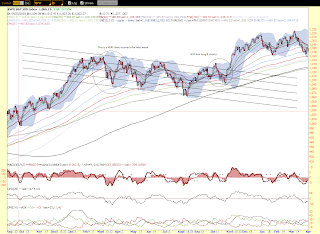There's a couple reasons on why it's crucial to scale in small short positions or stay cash.
1. This a fakeout before reaching new highs. In this case cover shorts as soon as the 50 EMA does not hold.
2. Worse yet, consecutive fakeouts while the market trades within a channel. This occurred in 2004 as the US emerged from the 2000 - 2003 recession. This zig zag scenario is a very likely for 2010, but no way to be certain. Trading this kind of a market is extremely difficult, as it takes both patience and additional forms of analysis. By strictly using the 2050 EMA rule, your account would take considerable hits from the fake outs. Nevertheless, it still can be done.
- The safest way to play this is to not play it at all - stay cash, or invest in stocks with great fundamentals and sell covered calls.
- Use channels once the first high/low swings are formed. Sell/buy according to the top/bottom of the channels. If the shorting at the upper channel and movement pierces to the upside, cover immediately. Vice versa.
- Use the 20/50 EMA rule, but enter positions strictly at the 20 or 50 EMA during the BACKTEST after a trend break. Get out immediately if the position doesn't go your way. Wouldn't recommend holding more than 2-3 days.
- Out of the 3 options, I believe staying cash or selling covered calls will be the best play.




lots of good advice. i'm curious why the 20 ema turns out to be less useful in a downtrend.
ReplyDeleteThis comment has been removed by the author.
ReplyDeleteJim, the 50 EMA is more crucial in a downtrend because stocks often break 20 EMAs in a downtrend in attempt to retest the 50 EMA much more frequently than stocks breaking 20 EMA and testing 50 EMA in an uptrend. Hence, if an uptrend stocks break 20 EMA, then you should be cautious. On the contrary, you should proceed with MORE caution when a stock touches 50 EMA on a downtrend vs 20 ema.
ReplyDelete